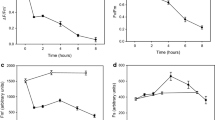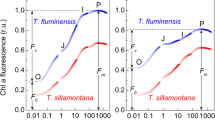Abstract
The sun-exposed peel of ‘Gala’ apple with or without sunburn was compared in terms of photooxidation and photoprotection, and a controlled experiment was conducted to probe the initial responses of PSII to high light and high temperature. The content of carotenoids, lutein and xanthophylls on a chlorophyll basis was higher in the sunburned peel although they were lower expressed on a peel area basis. Significant loss of β-carotene and neoxanthin was observed relative to chlorophylls in the sunburned peel. O2 evolution rates and the activity of key enzymes in the Calvin cycle were lower in the sunburned peel, but the activity of these enzymes decreased to a lesser extent than the O2 evolution rates. The activity of antioxidant enzymes in the ascorbate-glutathione cycle and the level of total ascorbate, total glutathione, and reduced glutathione were higher in the sunburned peel. However, the sunburned peel had higher H2O2 and malondialdehyde contents. Fruit peels treated with high temperature (45°C) alone showed a clear “K” step in their chlorophyll fluorescence transients whereas high temperature coupled with high light (1,600 μmol m−2 s−1) led to the disappearance of the “K” step and a further decrease in F V/F M (similar to what was observed in the sunburned peel). We conclude that high temperature coupled with high light damages the PSII complexes at both the donor and acceptor sides. Although both the xanthophyll cycle and the antioxidant system are up-regulated in response to the photooxidative stress, this up-regulation does not provide enough protection against the photooxidation.











Similar content being viewed by others
Abbreviations
- A:
-
Antheraxanthin
- APX:
-
Ascorbate peroxidase
- CAT:
-
Catalase
- Chl:
-
Chlorophylls
- DHA:
-
Oxidized ascorbate
- DHAR:
-
Dehydroascorbate reductase
- FBPase:
-
Stromal fructose-1,6-bisphosphatase
- PFD:
-
Photon flux density
- F O, F M :
-
Minimum and maximum fluorescence
- F V/F M :
-
Maximum quantum yield of PSII
- GPX:
-
Guaiacol peroxidase
- GR:
-
Glutathione reductase
- GSH:
-
Reduced glutathione
- GSSG:
-
Oxidized glutathione
- MDA:
-
Malondialdehyde
- MDAR:
-
Monodehydroascorbate reductase
- NADP-GAPDH:
-
NADP-glyceraldehyde-3-phosphate dehydrogenase
- OEC:
-
Oxygen evolving complex
- PSII:
-
Photosystem II
- Rubisco:
-
Ribulose-1,5-bisphosphate carboxylase/oxygenase
- SOD:
-
Superoxide dismutase
- PRK:
-
Phosphoribulokinase
- PGK:
-
3-phosphoglycerate kinase
- SOD:
-
Superoxide dismutase
- V:
-
Violaxanthin
- Z:
-
Zeaxanthin
References
Anderson JM, Park YI, Chow WS (1998) Unifying model for the photoinactivation of photosystem II in vivo under steady-state photosynthesis. Photosynth Res 56:1–13
Bradford MM (1976) A rapid and sensitive method for quantitation of microgram quantities of protein utilizing the principle of protein-dye binding. Anal Biochem 72:248–254
Chen LS, Cheng L (2003a) Carbon assimilation and carbohydrate metabolism of ‘Concord’ grape (Vitis labrusca L.) leaves in response to nitrogen supply. J Am Soc Hort Sci 128:754–760
Chen LS, Cheng L (2003b) Both xanthophyll cycle-dependent thermal dissipation and the antioxidant system are up-regulated in grape (Vitis labrusca L. cv. Concord) leaves in responses to N limitation. J Exp Bot 54:2165–2175
Chen LS, Cheng L (2007) The sun-exposed peel of apple fruit has a higher photosynthetic capacity than the shaded peel. Funct Plant Biol 34:1038–1048
Cheng L (2003) Xanthophyll cycle pool size and composition in relation to the nitrogen content of apple leaves. J Exp Bot 54:385–393
Cheng L, Fuchigami LH (2000) Rubisco activation state decreases with increasing nitrogen content in apple leaves. J Exp Bot 51:1687–1694
Cheng L, Ma FW (2004) Diurnal operation of the xanthophyll cycle and the antioxidant system in apple peel. J Am Soc Hortic Sci 129:313–320
Dall’Osto L, Cazzaniga S, North H, Marion-Poll A, Bassi R (2007) The Arabidopsis aba4-1 mutant reveals a specific function for neoxanthin in protection against photooxidative stress. Plant Cell 19:1048–1064
De Las Rivas J, Telfer A, Barber J (1993) 2-coupled β-carotene molecules protect P680 from photodamage in isolated photosystem II reaction centers. Biochim Biophys Acta 1142:155–164
Demmig B, Winter K, Krüger A, Czygan FC (1987) Photoinhibition and zeaxanthin formation in intact leaves. A possible role of the xanthophyll cycle in the dissipation of excess light energy. Plant Physiol 84:218–224
Dias DP, Marenco RA (2006) Photoinhibition of photosynthesis in Minquartia guianensis and Swietenia macrophylla inferred by monitoring the initial fluorescence. Photosynthetica 44:235–240
Feller U, Crafts-Brandner SJ, Salvucci ME (1998) Moderately high temperatures inhibit ribulose-1, 5-bisphosphate carboxylase oxygenase (Rubisco) activase-mediated activation of ribulose. Plant Physiol 116:539–546
Franklin LA, Levavasseur G, Osmond CB, Henley WJ, Ramus J (1992) Two components of onset and recovery during photoinhibition of Ulva rotundata. Planta 186:399–408
Gong Y, Mattheis JP (2003) Biochmical changes in ‘Fuji’ apple fruit peel induced by UV-B irradiation. HortSci 38:856
Griffith OW (1980) Determination of glutathione and glutathione disulfide using glutathione reductase and 2-vinylpyridine. Anal Biochem 106:207–212
Hakala M, Tuominen I, Keranen M, Tyystjärvi T, Tyystjärvi E (2005) Evidence for the role of the oxygen-evolving manganese complex in photoinhibition of photosystem II. Biochim Biophys Acta 1706:68–80
Harwod JL (1998) Involvement of chloroplast lipids in the reaction of plants submitted to stress. In: Siegenthaler P-A, Murata N (eds) Advances in photosynthesis. Lipids in photosynthesis: structure, function and genetics. Kluwer, the Netherlands, pp 287–302
Havaux M, Niyogi KK (1999) The violaxanthin cycle protects plants from photooxidative damage by more than one mechanism. Proc Natl Acad Sci USA 96:8762–8767
Henley WJ, Levavasseur G, Franklin LA, Osmond CB, Ramus J (1991) Photoacclimation and photoinhibition in Ulva rotundata as influenced by nitrogen availability. Planta 184:235–243
Hodges DM, DeLong JM, Forney CF, Prange RK (1999) Improving the thiobarbituric acid-reactive-substances assay for estimating lipid peroxidation in plant tissues containing anthocyanin and other interfering compounds. Planta 207:604–611
Leegood RC (1990) Enzymes of the Calvin cycle. In: Lea PJ (ed) Methods in plant biochemistry, vol 3. Academic Press, New York, pp 15–37
Logan BA, Grace SC, Adams WWIII, Demmig-Adams B (1998) Seasonal differences in xanthophylls cycle characteristics and antioxidants in Mahonia repens growing in different light environments. Oecologia 116:9–17
Ma F, Cheng L (2003) The sun-exposed peel of apple fruit has higher xanthophyll cycle dependent thermal dissipation and antioxidants of the ascorbate-glutathione pathway than the shaded peel. Plant Sci 165:819–827
Ma F, Cheng L (2004) Exposure of the shaded side of apple fruit to full sun leads to up-regulation of both the xanthophyll cycle and the ascorbate-glutathione cycle. Plant Sci 166:1479–1486
McCord JM, Fridovich I (1969) Superoxide dismutase. An enzymic function for erythrocuprein (hemocuprein). J Biol Chem 244:6049–6055
Merzlyak MN, Chivkunova OB (2000) Light-stress-induced pigment changes and evidence for anthocyanin photoprotection in apples. J Photochem Photobiol B: Biol 55:155–163
Merzlyak MN, Solovchenko AE (2002) Photostability of pigments in ripening apple fruit: a possible photoprotective role of carotenoids during plant senescence. Plant Sci 163:881–888
Osmond CB, Ramus J, Levavasseur G, Franklin LA, Henley WJ (1993) Fluorescence quenching during photosynthesis and photoinhibition of Ulva rotundata Blid. Planta 190:97–106
Patterson BD, MacRae EA, Ferguson IB (1984) Estimation of hydrogen peroxide in plant extracts using titanium (IV). Anal Biochem 139:487–492
Plaxton WC (1990) Glycolysis. In: Lea PJ (ed) Methods in plant biochemistry, vol 3. Academic Press, New York, pp 145–173
Rao MV, Paliyath G, Ormrod DP (1996) Ultraviolet-B- and ozone-induced biochemical changes in antioxidant enzymes of Arabidopsis thaliana. Plant Physiol 110:125–136
Rintamäki E, Salo R, Aro EM (1994) Rapid turnover of the D1 reaction-center protein of photosystem II as a protection mechanism against photoinhibition in a moss, Ceratodon purpureus (Hedw.) Brid. Planta 193:520–529
Salvucci ME, Osteryoung KW, Crafts-Brandner SJ, Vierling E (2001) Exceptional sensitivity of Rubisco activase to thermal denaturation in vitro and in vivo. Plant Physiol 127:1053–1064
Satoh S, Ikeuchi M, Mimuro M, Tanaka A (2001) Chlorophyll b expressed in cyanobacteria functions as a light-harvesting antenna in photosystem I through flexibility of the proteins. J Biol Chem 276:4293–4297
Schansker G, Tóth SZ, Strasser RJ (2005) Methylviologen and dibromothymoquinone treatments of pea leaves reveal the role of photosystem I in the Chl a fluorescence rise OJIP. Biochim Biophys Acta 1706:250–261
Schrader L, Sun J, Felicetti D, Seo JH, Jedlow L, Zhang J (2003) Stress-induced disorders: effects on apple fruit quality. Washington Tree Fruit Postharvest Conference, Wenatchee, http://postharvest.tfrec.wsu.edu/PC2003A.pdf
Schrader LE, Zhang J, Duplaga WK (2001) Two types of sunburn in apple caused by high fruit surface (peel) temperature. Plant Health Prog. doi:10.1094/PHP-2001-1004-01-RS
Shang W, Feierabend J (1999) Dependence of catalase photoinactivation in rye leaves on light intensity and quality and characterization of a chloroplast-mediated inactivation in red light. Photosynth Res 59:201–213
Shipton CA, Barber J (1991) Photoinduced degradation of the D1 polypetide in isolated reaction centers of photosystem II: Evidence for an autoproteolytic process triggered by the oxidizing side of the photosystem. Proc Natl Acad Sci USA 88:6691–6695
Song YG, Liu B, Wang LF, Li MH, Liu Y (2006) Damage to the oxygen-evolving complex by superoxide anion, hydrogen peroxide, and hydroxyl radical in photoinhibition of photosystem II. Photosynth Res 90:67–78
Srivastava A, Guissé B, Greppin H, Strasser RJ (1997) Regulation of antenna structure and electron transport in photosystem II of Pisum sativum at elevated temperature probed by the fast polyphasic chlorophyll a fluorescence transient: OKJIP. Biochim Biophys Acta 1320:95–106
Srivastava A, Strasser RJ (1996) Stress and stress management of land plants during a regular day. J Plant Physiol 148:445–455
Strasser BJ (1997) Donor side capacity of photosystem II probed by chlorophyll a fluorescence transients. Photosynth Res 52:147–155
Strasser RJ, Srivastava A, Tsimilli-Michael M (2000) The fluorescence transient as a tool to characterize and screen photosynthetic samples. In: Yunus M, Pathre U, Mohanty P (eds) Probing photosynthesis: mechanisms, regulation and adaptation. Taylor and Francis, London, pp 445–483
Strasser RJ, Srivastava A, Tsimilli-Michael M (2004) Analysis of the chlorophyll a fluorescence transient. In: Papageorgiou G, Govindjee (eds) Advances in photosynthesis and respiration. Chlorophyll fluorescence a signature of photosynthesis. Kluwer, the Netherlands, pp 321–362
Telfer A (2005) Too much light? How beta-carotene protects the photosystem II reaction centre. Photochem Photobiol Sci 4:950–956
Telfer A, Dhami S, Bishop SM, Philipps D, Barber J (1994) β-Carotene quenches singlet oxygen formed in isolated photosystem II reaction center. Biochemistry 33:14469–14474
Torres CA, Andrews PK, Davies NM (2006) Physiological and biochemical responses of fruit exocarp of tomato (Lycopersicon esculentum Mill.) mutants to natural photo-oxidative conditions. J Exp Bot 57:1933–1947
Trebst A, Depka B (1997) Role of carotene in the rapid turnover and assembly of photosystem II in Chlamydomonas reinhardtii. FEBS Lett 400:359–362
Uhrmacher S, Hanelt D, Nultsch W (1995) Zeaxanthin content and the degree of photoinhibition are linearly correlated in the brown alga Dictyota dichotoma. Mar Biol 123:159–165
Vass I, Styring S, Hundal T, Koivuniemi A, Aro EM, Andersson B (1992) Reversible and irreversible intermediates during photoinhibition of photosystem II: stable reduced QA species promote chlorophyll triplet formation. Proc Natl Acad Sci USA 89:1408–1412
Acknowledgments
This work was supported in part by Washington tree Fruit Research Commission. We thank Dr. David Felicetti and Dr. Larry Schrader at the Tree Fruit Research and Extension Center of Washington State University for their help in monitoring peel temperatures and collecting fruit samples, and Richard Raba for technical assistance. We also thank Dr. Huiyuan Gao at Shandong Agricultural University for helpful discussions on chlorophyll a fluorescence transients.
Author information
Authors and Affiliations
Corresponding author
Additional information
L.-S. Chen and P. Li contributed equally to this work.
Rights and permissions
About this article
Cite this article
Chen, LS., Li, P. & Cheng, L. Effects of high temperature coupled with high light on the balance between photooxidation and photoprotection in the sun-exposed peel of apple. Planta 228, 745–756 (2008). https://doi.org/10.1007/s00425-008-0776-3
Received:
Accepted:
Published:
Issue Date:
DOI: https://doi.org/10.1007/s00425-008-0776-3




